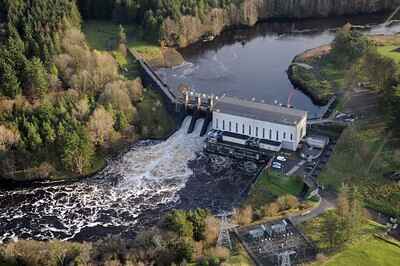Hydroponics Meaning, Mechanisms, Types, Systems and Plants
Hydroponics is the practice of growing plants in the absence of soil, using a solution that is rich in mineral nutrients. This article discusses hydroponics meaning, mechanisms, types, systems, and plants.
-Origin and History of Hydroponics
-The Concept of Hydroponics System
-Types (or Techniques) of Hydroponics System s
-What Type of Plants can be Grown Hydroponically?
Hydroponics Meaning
Hydroponics is a horticultural method whereby plants are grown without soil, by drawing nutrients from mineralized water.
Some of the most important terms that can be used in the definition of hydroponics include hydroculture, gardening, and horticulture.
Hydroponics is a practice by which the need for soil in plant growth, is eliminated, by replacing soil with a nutrient-rich solution.
The ‘plants’ which are grown by hydroponics method, vary across a wide range, and include ornamental plants and food crops.
Hydroponics is the growing of garden plants without soil. The term “hydroponics’ is itself derived from two Greek words; Hydro, which means Water, and Ponein, which means Labor [16].
Therefore, hydroponics is the prominent use of water in agricultural labor.
Hydroponics is the science of growing plants by supplying nutrients to their roots directly from a fluid, and without the mechanical support of soil.
As the definitions so far have shown, plants do not necessarily require soil for their growth and survival. Rather, the role of soil is mainly to provide mechanical support to plant roots and stems.
Plants survive by drawing dissolved, inorganic nutrients from water, which is held within the pore spaces of soil.
In hydroponics, mechanical support is provided by an alternative medium, while the nutrients are supplied in their dissolved state, from a solution.
In many cases, it has been observed that hydroponics allows plants to absorb nutrients at a more rapid and voluminous rate, than conventional agricultural methods [21].
Origin and History of Hydroponics
-Ancient Records of the Practice
One of the earliest records of practical hydroponics is the Hanging Gardens of Babylon [6].
These records date back as far as 600BC, and suggest that the Gardens of Babylon were grown without soil, deriving all their nutrients from the Euphrates River [15].
While this description is very similar to the modern practice of hydroponics, there is so far, no known, archeological evidence of the Gardens’ existence.
By 1100BC, the Aztec people of modern-day Mexico, practiced hydroponics by creating Chinampas or ‘artificial islands’ on swampy lakes [7].
These artificial islands are historically referred to as the ‘Floating gardens of Aztec,’ and there is existing archeological evidence that fairly align with the records [12].
However, some studies have argued that the ancient practice in Aztec was not hydroponics, as the plant roots were in fact imbedded in soil.
Marco Polo (1254-1324) documented sightings of rice paddies in Suzhou, China, in the 13th century [17]. He called the paddies ‘floating gardens’ because they were cultivated in swamps.
-The Seventeenth to Nineteenth Centuries
The 17th century saw some advancements in the study of hydroponics.
A 1627 posthumous publication by Sir Francis Bacon (1561-1626) called Silva Sylvarum was a pioneer in-depth analysis of the cultivation of plants without soil [14].
Jean Baptist van Helmont, a Belgian scientist, carried out extensive research on hydroponics, the results of which were published in 1648 [5]. In his research, it was observed that plants can derive all their nutrients, and survive, in the absence of soil.
The research involved an experiment, whereby a five-pound willow tree was planted with only 200 pounds of soil, in a vessel. For a period of five years, only distilled water and rainwater were added to the vessel.
At the end of the five-year period, a 169-pound tree had grown, mainly on water. This observation formed a strong foundation for the credibility of the hydroponics concept.
In the year 1699, John Woodard (1665-1728); an English naturalist, produced the first known hydroponics solution [8]. This solution was a major component of a series of ‘water culture’ experiments based on the cultivation of spearmint.
He published a study that same year, which suggested that hydroponics provides a more effective mechanism for nutrient absorption by plants.
By the 19th century, new discoveries in the field of hydroponics; had come to include methods for the production of effective hydroponics solutions.
One of such discoveries is the formula proposed by the German scientist Julius von Sachs (1832-1897) in 1860 [4].
This formula described a method for producing a nutrient solution that could be used for hydroponics. It served as a reference point for future nutrient solution-production methods.
-Hydroponics in the Twentieth and Twenty-First Centuries
Dr. William Frederick Gericke (1882-1970); a professor at the University of California, is a pioneer of modern hydroponics [9].
He coined the term from its Greek components in 1937, and performed elaborate experiments to determine the effectiveness of hydroponics for growing various plants, including commercial crops.
Results of these experiments include the cultivation of a 25-feet high tomato plant, solely with nutrient solution [5]. William Frederick Gericke is considered to be the Father of Modern Hydroponics due to these results, which proved the agricultural potential of the practice.
Inspired by William Frederick Gericke’s work, Ernest W. Brundin, an American businessman founded the Chemical Culture Company in 1938; which delivered services in hydroponics development.
The Chemical Culture Company patented the Chemical Agriculture System in 1938; which was basically a simplified hydroponics system.
A 1940 publication by William Frederick Gericke, titled; Complete Guide to Soilless Gardening, provided a summary of the most prominent findings in the field of hydroponics at the time.
In the Second World War, some of the known techniques were used by the United States military, as well as the British, to grow crops for service members.
The Nutrient Film Technique (NFT) was introduced in England, in 1965, by Allen Cooper [1].
It is one of the first hydroponic techniques involving the mobilization of water, and is based on a mechanism by which a shallow stream of nutrient solution is made to flow through a vessel which brings it in contact with the roots of plants, that draw nutrients from the solution.
Aeroponics, another sophisticated method of hydroponics, was introduced in 2014, by Caleb Hunter and a team of professionals at the MIT Media Lab. The method involves application of the nutrient solution using a spraying mechanism.
As at 2019, a company by the name Emirates Flight Catering and Crop One Holdings, was set to complete what is regarded as an expansive hydroponics farm, in Dubai [19].
With a 130,000 square-foot area and modern agricultural technologies, this hydroponics farm is said to be capable of producing crops with far less water and land space than required for conventional agriculture.
-Future Trends in the Hydroponics Field
Potential future developments in the field of hydroponics include the integration of smart technologies like Domotics (smart house technology), Internet of Things (IoT), and Artificial Intelligence, into hydroponic practices.
Integration of these technologies will ensure that upcoming methods of hydroponics are more efficient and effective.
It will also lead to the automation of most hydroponic processes, and will enable the regulation of factors like light, temperature, CO2 levels, nutrient concentration, and pH.
The future growth and development of the field of hydroponics are aligned with the agenda of sustainable development; which aims to address food insecurity, reduce greenhouse emissions, and improve global economic conditions.
As a biotechnological market, the growth of the hydroponics industry is projected to increase steadily in the future. According to some predictions, the value of the hydroponics market will be up to $16 billion dollars by 2025 [10].
How Hydroponics Works
Hydroponics works by mechanical support, nutrient dissolution, and nutrient absorption, all of which result in the supply of mineral nutrients to the plant.
Each of these factors is discussed as follows;
1). Mechanical Support
Because of the absence of soil, hydroponics plants usually require an alternative means of mechanical support.
For relatively-small plants, support is provided by the vessel in which the plant grows. A good example of a hydroponics vessel is the net pot. These vessels are usually designed to align with the geometry, size and root structure of the plant.
In the case of larger plants with broad and/or irregular growth patterns, other forms of support may be needed.
One option is to support the roots of the plant with materials called growth media, such as clay pellets, rockwool, peat moss, and perlite [20]. This is helpful especially when the plant has a large center of gravity and can be supported at its base.
Alternatively, a trellis can be used to support large hydroponics plants. In order for this method to be effective, the plant’s growth can be directed toward the trellis, or the plant can be tied to the trellis.
2). Nutrient Dissolution
In hydroponics, the source of nourishment for the plants is a mineral-rich solution.
To achieve this solution, the required nutrients must be dissolved in water. The act of dissolving these nutrients is described as ‘nutrient dissolution’.
Nutrient dissolution is simply the act of adding nutrients to water, to produce a hydroponic mixture containing macro-nutrients like phosphorus, calcium, magnesium, sulfur and nitrogen; as well as micro-nutrients like cobalt, chlorine, zinc, copper, iron, manganese, boron and molybdenum.
An advantage of hydroponics is that it enables the required nutrients to be supplied in the required quantity, for optimal growth of the plant.
There are various hydroponics fertilizer products that can be used to produce the mineralized, nutrient-rich solution. The choice of product, and the mode of application, usually depend on the specific needs of the plant.
When preparing a hydroponics solution, there are some other parameters aside nutrient-composition, that should be considered. These include pH, temperature, dissolved oxygen, and electrical conductivity [11].
3). Nutrient Absorption
Plants must be able to absorb nutrients from the hydroponic solution, in order for the practice of hydroponics to be beneficial.
Nutrient absorption occurs when plant roots take up required minerals in the form of ions, from a solution, through an osmotic mechanism.
In natural ecosystems, nutrients are produced when microbes breakdown organic matter through the process of biodegradation. These nutrients may be dissolved in soil water, from which they are soon absorbed by plants.
On the other hand, in hydroponics; nutrients are made readily available for direct absorption by plant roots. When the right quantity of the right nutrients is made available, hydroponic plants may grow at a faster rate than their soil-grown counterparts.
There are different ways by which nutrients are supplied to the plant from the hydroponics solution. In some cases, the solution itself is circulated, thereby minimizing loss by evaporation.
Circulation of the solution may also result in better contact between the plant roots and the solution.
In order for nutrient absorption to be effective, external factors such as the degree of light exposure, should be considered. These factors also affect the growth of the plant.
The Concept of Hydroponics System
A hydroponics system is a system equipped to provide mechanical support, nutrient solution, and nutrient absorption-mechanism, for hydroponics plants.
A god hydroponics system must account for the mechanical support needed by the plant in the absence of soil; the containment of the nutrient solution; and the contact between the plant and the solution.
Types (or Techniques) of Hydroponics Systems
The six types of hydroponics systems are; Aeroponic, Drip, Ebb and Flow, Nutrient Film Technology (NFT), Water Culture, and Wick systems.
1). Aeroponic System
As the name implies, an aeroponic system is a type of hydroponic system in which the plants are suspended in the air [2].
The nutrient solution in this system, is applied using nozzles, which are usually beneath the plants. From their low position, the nozzles will spray nutrient solution upon the roots of the plants, which absorb the required nutrients for their growth.
Flow of the nutrient solution from the mist nozzles is regulated using a pump, which uses a pressure mechanism to control the rate of fluid flow.
Aeroponic systems are efficient and do not use excessive amounts of nutrient solution, as the solution is sprayed as a fine mist, which comes in contact with the roots of the plants.
Also, the plants themselves are exposed to more oxygen in this hydroponics technique, which often boosts their growth rate.
The spray may occur continuously, or in cycles. Disadvantages of these systems include the possibility of nozzle-clogging, and the high cost of building the system.

2). Drip System
The drip system is a type of hydroponics system that works by supplying a nutrient solution to plants, using a drip mechanism.
Drip systems are suited for large-scale, commercial purposes [13]. In these systems, a tube transmits the nutrient solution, which is usually fed into the tube by a pump.
The end of the tube is fitted with a drip emitter which regulates the rate of drip-flow, according to the requirement of the plant.
The system is usually designed such that nutrient solution is effectively recycled. Like the aeroponics system, the flow may be either continuous or in a cycle-pattern.
3). Ebb and Flow System
The Ebb and Flow system is a type of hydroponics system that works based on a mechanism of repetitive flooding and draining, whereby the nutrient solution is made to come in contact with the roots of the plant, without preventing the supply of oxygen as well.
In the Ebb and Flow system, plants are placed with their roots in a vessel, which is flooded and drained with nutrient solution, in a cyclic manner [18]. Most of these systems are equipped with a pump-timer that regulates the pattern of flow into and out of the vessel.
For mechanical support, materials like perlite or rockwool can be used to hold the base of the plants. Ebb and flow technique has been used to cultivate various plants. However, it may not be effective in some scenarios, such ad for large-scale agriculture.
One of the main drawbacks of the technique is that it can lead to over-saturation of the plant.

4). Nutrient Film Technology (NFT) System
The Net Film Technology (NFT) system is a hydroponics system that works by delivering a thin, flowing film of nutrient solution to plants.
In NFT systems, the plants are usually contained in net pots [23], which allow their roots to make effective contact with the nutrient solution.
The system is usually comprised of a nutrient solution reservoir, which uses a pump system to transmit the solution into a sloped channel. As the solution flows in a thin film, through this channel, it makes contact with the roots of plants.
Effective recycling also occurs in the system, whereby the fluid flows back to the reservoir after each phase of flow, creating a continuous circulation pattern.
NFT hydroponics technique does not require the roots of plants to be submerged [22]. This is an advantage because it allows for effective oxygenation of the plant roots.
The technique has another advantage of being scalable, as it can be designed to suit various scales of plant cultivation. It is however best suited for small-scale cultivation.
Potential problems include unfavorable root growth patterns, malfunctioning of the pump, and clogging of the fluid supply outlets.
5). Water Culture System
The water culture system is a highly-simplified type of hydroponics system, in which the plant roots are totally submerged in the nutrient solution.
Otherwise known as the ‘Deep Water Culture’ system; this system is usually comprised of a reservoir containing a nutrient solution, in which the roots of plants are submerged.
While this setting provides a constant supply of nutrients to the plants, a lack of oxygen due to submergence can be harmful.
An air stone, air pump, or water diffuser is often used to supply air to the plant roots by directly introducing this air into the nutrient solution.
To provide mechanical support, net pots are commonly used.
The water culture hydroponics system has some advantages, such as its relatively-low cost, ease of maintenance, and minimization of water and nutrient wastage.
However, care must be taken to ensure that the plants do not suffocate.
6). Wick System
Wick system is a passive, basic type of hydroponics system, which works based on the transfer of a nutrient solution to plant roots through a wick.
The wick system is the simplest type of hydroponics system [3]. It is called ‘passive’ because the system does not require any pumping mechanism, aerator, or mechanical parts [22].
In some wick systems, the wick itself is replaced by an absorbent material like vermiculite or perlite. Wicks may be made of cloth or nylon.
Because of the direct absorption mechanism of wick systems, they are usually able to supply nutrients to the plants at a rate and quantity that equals the exact needs of the plants.
The biggest advantage of the wick system is its simplicity. It is a fairly simple hydroponics technique, requiring minimal maintenance.
However, the simplicity of the wick system also implies that it is not convenient for large plants. Also, improper setup of the wick or absorbent medium, can render the technique ineffective.

What Type of Plants can be Grown Hydroponically?
The main types of plants that can be grown hydroponically are herbs, vegetables and fruits.
These types of plants are best suited for hydroponics because of their relative simplicity in terms of anatomical structure, growth pattern, and mode of nutrient absorption.
Plants which can be grown hydroponically include celery, cucumber, spinach, lettuce, tomatoes, green beans, pepper, watercress, kale, strawberries, basil, parsley, thyme, oregano, mint, cilantro, chamomile, and lemon balm.
Conclusion
Hydroponics is a horticultural method of growing plants without soil, by allowing the plants to derive their nourishment from a nutrient-rich solution.
The term is derived from two Greek words; Hydros and Ponein, which mean ‘Water’ and ‘Labor’ respectively.
Hydroponics dates back to ancient times, with records showing a likelihood of the practice having occurred in Babylon as at 600BC. Other regions where hydroponics is likely to have been used within this period include China and Aztec (Mexico).
Hydroponics works by a mechanism whereby the plant receives mechanical support, a nutrient solution, and a mode of absorption of nutrients from the solution.
The working principle of hydroponics can be summarized into three components; mechanical support, nutrient dissolution, and nutrient absorption. A hydroponics system is a system which is equipped to provide these three components.
There six types of hydroponics systems are;
- Aeroponic System
- Drip System
- Ebb and Flow System
- Nutrient Film Technology (NFT) System
- Water Culture System
- Wick System
Types of plants that can be grown hydroponically include herbs, vegetables, and fruits.
Examples of hydroponics plants are;
- Celery
- Cucumber
- Spinach
- Lettuce
- Tomatoes
- Green beans
- Pepper
- Watercress
- Kale
- Strawberries
- Basil
- Parsley
- Thyme
- Oregano
- Mint
- Cilantro
- Chamomile
- Lemon balm
References
1). Ahmed, M. G.; Alam, M. F.; Nuruzzaman, M.; Shohael, M. A.; Nasiruddin, A.; and Hossain, M. M. (2003). “Evaluation of Nutrient Film Technique and Sand Culture for Year-round Production of Tomato (Lycopersicon esculentum Mill.) in Tropical Asia.” Asian Journal of Plant Sciences, 2: 420-424. Avaiable at: https://doi.org/10.3923/ajps.2003.420.424. (Accessed 29 March 2022).
2). Amber (2020). “What Is The Difference Between Hydroponics vs Aeroponics?” Available at: https://thegreengardenlife.com/hydroponics-vs-aeroponics/. (Accessed 29 March 2022).
3). D’Anna, C. (2019). “Wick System Hydroponic Gardens.” Available at: https://www.thespruce.com/hydroponic-gardens-wick-system-1939222. (Accessed 29 March 2022).
4). Danko, D. (2008). “The History of Hydroponics.” Available at: https://www.thcfarmer.com/threads/the-history-of-hydroponics.370/. (Accessed 29 March 2022).
5). Edwards, J. (2015). “HYDROPONICS HISTORY PART 1.” Available at: http://hydroponicgardening.com/history-of-hydroponics/water-culture-hydroponics-history/. (Accessed 29 March 2022).
6). Folds, E. (2018). “The History of Hydroponics.” Available at: https://evanfolds.medium.com/the-history-of-hydroponics-99eb6628d205. (Accessed 29 March 2022).
7). Johnson, L. (2015). “AZTEC CHINAMPAS OF CENTRAL AMERICA.” Available at: https://ezgrogarden.com/history-of-hydroponics-2/aztec-chinampas-of-central-america/. (Accessed 29 March 2022).
8). King, J. (2020). “A Brief History of Hydroponics.” Available at: https://blog.growlink.com/a-brief-history-of-hydroponics. (Accessed 29 March 2022).
9). Kiran; Nimbal, S.; Kamboj, M. C. (2022). “Ultra-Modern Farming System “HYDROPONICS” Available at: https://krishijagran.com/featured/ultra-modern-farming-system-hydroponics/. (Accessed 29 March 2022).
10). Kumar, A. (2020). “Hydroponics: An eco-friendly approach to farming.” Available at: https://timesofindia.indiatimes.com/readersblog/akash-kumar/hydroponics-an-eco-friendly-approach-to-farming-20741/. (Accessed 29 March 2022).
11). Meselmani, M. A. A. (2022). “Nutrient Solution for Hydroponics’, in M. Turan et al. (eds.), Soilless Culture [Working Title]”. IntechOpen, London. Available at: https://doi.org/10.5772/intechopen.101604. (Accessed 29 March 2022).
12). Morehart, C.; Frederick, C. (2014). “The chronology and collapse of pre-Aztec raised field (chinampa) agriculture in the northern Basin of Mexico.” Antiquity 88(340):531-548. Available at: https://doi.org/10.1017/S0003598X00101164. (Accessed 29 March 2022).
13). Raz, A. (2014). “Successful implementation of large-scale drip irrigation projects: An exploratory study of the socio-economic impact of the apmip among smallholders in india.” Acta Horticulturae 1015(1015):283-294. Available at: https://doi.org/10.17660/ActaHortic.2014.1015.31. (Accessed 29 March 2022).
14). Rees, G. (1981). “An unpublished manuscript by Francis: Sylva Sylvarum drafts and other working notes.” Annals of Science, Volume 38, 1981. Available at: https://doi.org/10.1080/00033798100200291. (Accessed 29 March 2022).
15). Rosenberg, J. (2019). “The Hanging Gardens of Babylon.” Available at: https://www.thoughtco.com/the-hanging-gardens-of-babylon-1434533. (Accessed 29 March 2022).
16). Singer, J. (2021). “A Brief Overview of the History Of Hydroponics.” Available at: https://gardenculturemagazine.com/a-brief-overview-of-the-history-of-hydroponics/. (Accessed 29 March 2022).
17). Souther, J. (2007). “China’s water world The ancient water-towns of the Yangtze estuary are a refuge from the urban and industrial sprawl of modern China.” Available at: https://www.piquenewsmagazine.com/travel/chinas-water-world-the-ancient-water-towns-of-the-yangtze-estuary-are-a-refuge-from-the-urban-and-industrial-sprawl-of-modern-china-2476945. (Accessed 29 March 2022).
18). Tomashenko, M. (2020). “What is ebb flow hydroponics?” Available at: https://findanyanswer.com/what-is-ebb-flow-hydroponics. (Accessed 29 March 2022).
19). Tormey, K. (2018). “Emirates Flight Catering builds world’s largest vertical farming facility in Dubai.” Available at: https://www.emiratesflightcatering.com/about-us/news-press/emirates-flight-catering-builds-world-s-largest-vertical-farming-facility-in-dubai/. (Accessed 29 March 2022).
20). Whyte, M. (2018). “New To Hydroponic Gardening? What Beginners Need to Know.” Available at: https://gardenculturemagazine.com/hydroponic-gardening-beginners-need-to-know/. (Accessed 29 March 2022).
21). Wolken, R. (2021). “Do hydroponic plants grow faster? Here’s everything you need to know.” Available at: https://www.happysprout.com/inspiration/hydroponic-plant-growth/. (Accessed 29 March 2022).
22). Woodard, J. (2019). “What Are Hydroponic Systems and How Do They Work?” Available at: https://www.freshwatersystems.com/blogs/blog/what-are-hydroponic-systems. (Accessed 29 March 2022).
23). Wortrich, R. (2022). “NFT Hydroponic System (Everything you need to know)”. Available at: https://climatebiz.com/nft-hydroponic-system/. (Accessed 29 March 2022).



